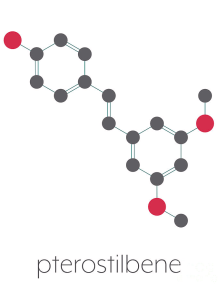ActiveRelease™ Pterostilbene (Resveratrol Dimethyl Ether, Encapsulation)
- Product Code: 45984
an encapsulation of Pterostilbene (also known as Resveratrol Dimethyl Ether) that can actively permeate skin and directly dissolve in water
an encapsulation of Pterostilbene (also known as Resveratrol Dimethyl Ether) that can actively permeate skin and directly dissolve in water
ActiveRelease™ Pterostilbene, an encapsulation of Pterostilbene (also known as Resveratrol Dimethyl Ether) that can actively permeate skin and directly dissolve in water.
Here is the summary on the skin benefits of Pterostilbene:
1. Potent UV Protection and Anti-Aging Properties
One of the primary causes of premature aging is exposure to ultraviolet (UV) radiation, specifically UVB rays, which are notorious for damaging skin cells. This damage can manifest as wrinkles, fine lines, hyperpigmentation, and, in severe cases, skin cancer. The study on pterostilbene's effects on SKH-1 hairless mice, a model commonly used in dermatological research, highlights its exceptional ability to protect the skin from UVB-induced damage.
In the study, pterostilbene was applied topically to mice before they were exposed to UVB radiation. The results were striking. Mice treated with pterostilbene showed significantly reduced skin thickness and redness compared to untreated mice, indicating that pterostilbene effectively mitigates the acute effects of UV exposure. These outcomes suggest that pterostilbene could help prevent the visible signs of photoaging, such as wrinkles and loss of skin elasticity, making it an ideal ingredient for anti-aging skincare formulations.
2. Superior Antioxidant Defense
Oxidative stress, caused by an imbalance between free radicals and antioxidants in the body, is a major contributor to skin aging and damage. UV radiation exacerbates oxidative stress by increasing the production of free radicals, which can damage cellular components like DNA, proteins, and lipids. This damage not only accelerates the aging process but also increases the risk of skin cancer.
Pterostilbene has been shown to boost the skin’s natural antioxidant defenses. The study found that pterostilbene treatment maintained the levels of crucial antioxidant enzymes such as glutathione, catalase, superoxide dismutase, and glutathione peroxidase close to normal, even after UVB exposure. In contrast, untreated mice experienced a significant depletion in these enzymes, leaving their skin vulnerable to oxidative damage.
Additionally, pterostilbene significantly reduced markers of oxidative damage, such as 8-hydroxy-2'-deoxyguanosine (a marker of DNA damage), protein carbonyls, and isoprostanes (markers of lipid peroxidation). These findings underscore pterostilbene’s role as a powerful antioxidant that can protect the skin at the molecular level, preventing the breakdown of collagen and elastin that leads to wrinkles and sagging.
3. Protection Against Skin Carcinogenesis
One of the most compelling reasons to include pterostilbene in your skincare products is its potential to prevent skin cancer. Chronic exposure to UV radiation is a well-known risk factor for the development of skin cancers, including basal cell carcinoma, squamous cell carcinoma, and melanoma. The research demonstrated that pterostilbene provides substantial protection against UVB-induced skin carcinogenesis.
In the study, mice were exposed to chronic UVB radiation over six months, a scenario designed to mimic long-term sun exposure in humans. Remarkably, 90% of the mice treated with pterostilbene did not develop skin tumors, while all of the control mice (those not treated with pterostilbene) developed multiple skin carcinomas. This dramatic reduction in tumor incidence suggests that pterostilbene could be an effective ingredient in products aimed at individuals with high sun exposure or those looking to prevent skin cancer.
4. Activation of the Nrf2 Pathway: A Cellular Defense Mechanism
Pterostilbene’s protective effects are partly due to its ability to activate the Nrf2 pathway, a critical regulator of cellular antioxidant responses. The Nrf2 pathway controls the expression of various antioxidant and detoxifying enzymes that help protect cells from oxidative stress and damage.
In human keratinocytes (HaCaT cells), which are the predominant cell type in the outermost layer of the skin, pterostilbene was shown to activate the Nrf2 pathway. This activation enhances the skin’s resilience against environmental stressors like UV radiation, pollution, and even toxins. By incorporating pterostilbene into skincare formulations, you can offer consumers a product that not only addresses the visible signs of aging but also strengthens the skin’s defense mechanisms at a cellular level.
5. Comparative Advantage Over Resveratrol
Resveratrol, another popular antioxidant found in red wine, has been widely promoted for its skin benefits. However, pterostilbene, a naturally occurring derivative of resveratrol, has several advantages that make it a superior choice for skincare products.
How to use: Can be used with all products such as gels, serums, lotions or creams.
Mixing method: mix in water phase. Do not expose to heat above 40C
Usage rate: 0.1-5%
Product characteristics: white to off-white powder
Solubility: Can be dissolved in water.
Storage: Store in the refrigerator at 4 ° C - 8 ° C
INCI : Hydroxypropyl Cyclodextrin, Resveratrol Dimethyl Ether
| Mechanism | - |
| Appearance | - |
| Longevity | - |
| Strength | - |
| Storage | - |
| Shelf Life | - |
| Allergen(s) | - |
| Dosage (Range) | - |
| Recommended Dosage | - |
| Dosage (Per Day) | - |
| Recommended Dosage (Per Day) | - |
| Mix Method | - |
| Heat Resistance | - |
| Stable in pH range | - |
| Solubility | - |
| Product Types | - |
| INCI | - |
Purchase History for
Cart
No products



